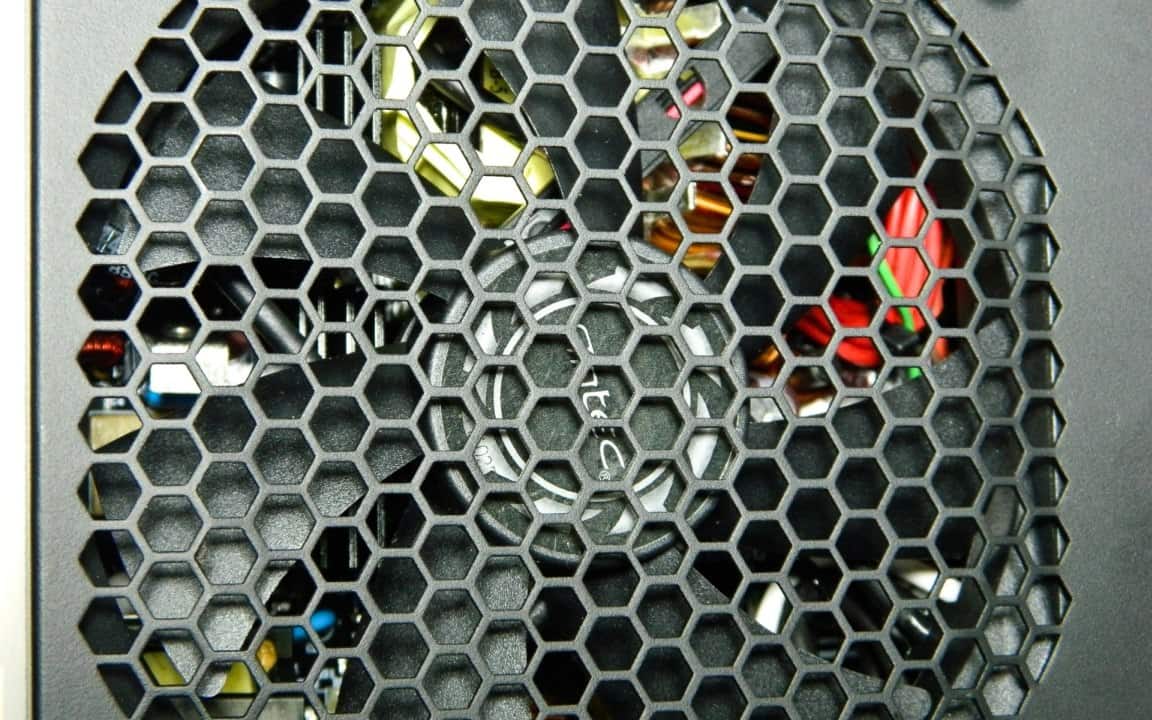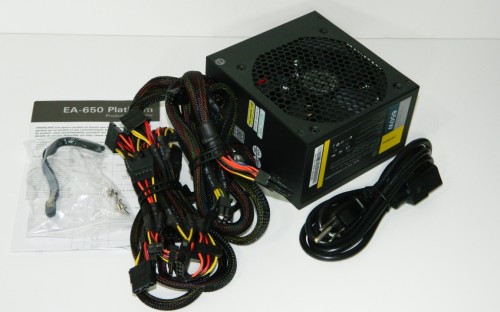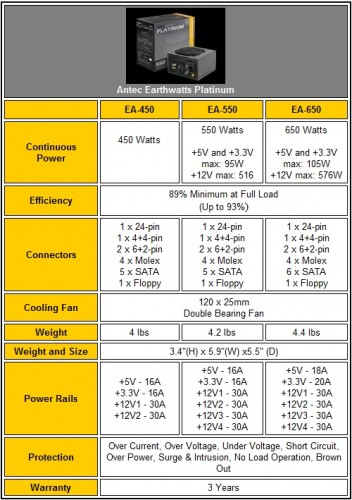An 80PLUS certified PSU ensures that the system runs as lean and efficient as possible resulting in lower power consumption. This helps lower power bills, especially if you run multiple systems. It’s sad that HP, Gateway or Dell branded desktop computers don’t use them, making them all quite wasteful. However, enthusiasts who build or order custom systems can really benefit from an 80PLUS. That’s why we’ve got two 80PLUS Platinum level power supplies to play with today.
The EarthWatts EA-650 is designed to provide solid, efficient power to users with single and dual video cards without costing too much money. The High Current Pro HCP-1000 was developed for more serious enthusiasts who run multiple video cards and lots of peripherals. Let’s find out if the Platinum EarthWatts and High Current Pro 1000 are worth more than their weight in gold platinum.
Features and Specifications – Antec EarthWatts EA-650 Platinum
The Platinum standard is the best choice for putting power consumption back in check, especially if you’re running higher end components. The EarthWatts series has been a long time entry level bang for buck power supply among price/quality conscious consumers. Its non-modular cabling helps cut costs and keeps things simple for users who want the simplicity.
Some local shops I’ve talked to personally, have found these to be a good choice because they rarely came back with issues. Below, you can see the differences and similarities in features in the line up.
Some notes worth mentioning are the max output specs on the 550 and 650 Platinum. If you do the math, that’s 611 watts max output on the EA-550 and 681 watts max output on the EA-650 respectively. Yes, this means these PSUs will exceed their model value. How much though depends on components like the main capacitors, MOSFETs and heat.
The Antec EA-650 Platinum retails for $119.99 US and comes with a 3 year warranty.
Features and Specifications – Antec High Current Pro HCP-1000 Platinum
The High Current Pro Platinum series is Antec’s sentinel of efficiency designed for high end systems running multiple power hungry components like gamers and professional content creators. The HCP-1000 Platinum is their best efficient model PSU while the rest of the HCP series is all Gold certified topping out at 1200 watts. These are your best options if running 3-way or more NVIDIA SLI or AMD CrossFireX graphics. 4-way graphics will require the HCP-1200 model. Also, the HCP series is completely modular right down to the main ATX power cable.
The max +12V output is 40 amps on each individual rail. That protects your components. The average output will probably be more around 30 amps depending on your particular configuration. Cabling is slightly different between the models. You can also see that only the HCP-1000 is Platinum efficient while the rest of the series are Gold efficient. Don’t let that deter you though as the entire line is very strong. More on that in testing later.
The Antec HCP-1000 Platinum retails for $259.99 US and comes with a very impressive 7 year warranty.
Let’s discuss a couple of important components that make up these power supplies and point to their overall quality.
Quality Control – What Makes Them Tick!
Inside the EA-650, the smaller supporting capacitors are Nippon Chemi-con and the main 390uF 420V capacitor is made by CapXon. CapXon caps are made in China and don’t fair well in very hot environments despite their 105C operative max temp rating. However, if you keep CapXon caps cool with decent airflow, they tend to last longer. Perhaps this explains why the fab used a Yate Loon case fan for cooling which are know to be very good.
The EarthWatt’s specs don’t disclose any fan specifications. The fan’s label indicates it’s a Yate Loon D12BH-12 which is indeed a case fan. Comparing the model number online, the 120mm fan is rated up to 41 dB moving about 89 cubic feet of air a minute. While this may seem like overkill, it needs to keep the MOSFETs, switching and caps as cool as possible.
Inside the HPC-1000, four heat sinks keep the mission sensitive MOSFETs cool. However, this unit has nicer switching components and two Nippon 450V – 470uF capacitors which are more resilient than CapXon. The combined 940uF helps provide much needed power with a PFC controller making sure its rated efficiency is maintained. In simpler terms, the right combination of switching, MOSFETs, capacitors and controller have been assembled to ensure Platinum efficiency.
The HPC series uses a single 135mm cooling fan. I couldn’t find exact specifications for the fan which is made by Delta but the best educated guess is it probably produces just around 100 CFM without breaking 1600 RPMs. Delta fans tend to be found in a lot of pro equipment and are usually quite loud. The odd size will hinder users from easily finding a replacement should the fan fail “after” the warranty expires. Otherwise, Antec is happy to support if something goes wrong.
Connectors Examined and Compared
Both PSU’s cables are braided with what appears to be standard nylon with heat shrink wrap at the ends. Each cable is relatively pliable and won’t rub off any vital epidermal layers when handling. All of the wiring felt pretty well secured to the connectors.
The EA-650’s MOLEX, SATA and PCIE cable lengths are 32 to 40 inches which is enough for mid tower cases if you want to do a little creative routing. However, the 4×4-pin EPS and main ATX main cables are 22 and 24 inches. The EPS isn’t quite long enough to route behind motherboard trays in mid tower or full tower cases with wire management. The 24-pin will probably just make it depending on your board placement. You may have to pick up some cable extensions like the NZXT. ones we reviewed.
The HCP-1000 MOLEX, SATA and PCIE are all about the same length as the EA-650 PSU. However, the 4×4-pin and 8-pin EPS cables are also about 30 inches which better supports good cable management. The main 24-pin length is about 26 inches which is fine given the number of cases with grommet holes for routing.
If you’re wondering how the cabling and PSU sockets fit, it’s spot on perfect. The cabling fits very tightly in to the PSUs sockets with absolutely no play, or wiggle room. You won’t have to worry about them slipping out some how. But, you will have to put some finger power in when removing them.
Test System Setup
The test system we use is to mainly to ensure the power supply can provide power and efficiency up to max output specs. The motherboard software and HWMonitor Pro come in handy for looking to see what kinds of power rail voltage it sees from an end user’s perspective.
Common Components:
- Processor: Core i7-3960X Sandy Bridge-E
- Motherboard: ASUS P9X79-V PRO
- Memory: Kingston HyperX 16GB 1600MHz DDR3
- Storage: Kingston HyperX 120GB SSD
- Enclosure: NZXT. Switch 810 (White)
Variables:
- EA-650 used two ZOTAC GTX 560 Ti SLI
- HPC-1000 used two ZOTAC GTX 580 SLI
From a tech’s perspective, an o-scope answers the question of whether ripple and efficiency are up to specs listed on the label. A load circuit was used to check max output limits and to make sure protective measures built into the power supply unit actually work. The last detail was keeping track of the highs and lows on each power rail while the PSUs are fully tested.
Antec EA-650 – Voltage, Efficiency and Max Load Performance
The rails were monitored while performing regular operations running back to back benchmarks keeping an eye on fluctuations and efficiency. Then, the PSU was artificially loaded down to see where it maxed out while again controlling the load. Here’s what we found out about the EA-650.
In terms of efficiency, the main power plant components ensure that efficiency is up to Platinum standards. The loaded rails did drop a bit below their stock rated specs. While this looks like a negative, it’s still well above levels that would be cause for concern. Fortunately, the power plant does manage ripple relatively well keeping things pretty steady during rising and falling output.
The maximum output repeatedly produced by the EA-650 was 748 watts while still maintaining at least an 85% efficiency. Buying this PSU expecting to squeeze an extra 100 watts from it is not recommended though. This PSU would best suit users powering a 6-core processor and up to two GTX 560 Ti in SLI, as an example. What this does reveal is that the EA-650 isn’t flexing its heart out at its rated output so it will support your system properly while giving you every what you’ve paid for.
Antec HCP-1000 – Voltage, Efficiency and Max Load Performance
Like the EA-650, the rails of the HCP-1000 were monitored while performing regular operations running back to back benchmarks keeping an eye on fluctuations and efficiency. Then, the PSU was artificially loaded down to see where it maxed out while again controlling the load. Now let’s see how the HCP-1000 did!
The HCP-1000 handles the rated wattage perfectly. The numbers here are all well within the realm of great performance. You don’t have to worry about whether or not this PSU provides power within acceptable tolerances. Each rail was very stable with very little ripple no matter the power draw. In fact, it was very similar to the EA-650 which shows that the PFC controllers are doing their job.
Fan Noise Examined
The EA-650 Platinum isn’t too audible under 300 watts but starts to creep above 19dB all the way up to 36dB under load. This is pretty typical for a PSU used in a normal system. The reason for the loud fan may have something to do with the 4 x 2.25″ heat sink and those CapXon caps that need extra cooling. However, it unfortunately eliminates it as a possible model for system integrators who like lower noise components. This should be considered if you’re building a quiet system.
Naturally, the HCP-1000 is a much different animal and not quite a wolf. Its odd sized 135mm cooling fan is relatively quiet right up till about 700 watts at which point this PSU growls. It doesn’t go above 28dB or so depending on the wattage drawn. The air comes out the back so quickly that the it is just barely warm suggesting there’s room to slow this fan unit down. Till then, this unit won’t work in any silent systems either. For standard users and gamers, the HCP-1000 is right on the money though.
Final Thoughts – Antec Earthwatts Platinum 650 (EA-650)
The goal of the Antec EarthWatts Platinum is to step away from the conventional mainstream quality and offer power conscious users a very efficient, yet respectively affordable, option. While its power rails are well within tolerance, it would really have said “all platinum” if the voltages were closer to their perspective rails. Still, users can expect a full 650 watts while maintaining 89% efficiency. There’s even extra power underneath if you’re really against the wattage wall. It’s plenty strong enough to handle any system with a couple GTX 560 Ti with room a bit of room to spare.
The quality and design is good and the details seem to point to it being built by FSPGroup or Fortron who is known for making very reliable server power supplies. However, similar to those designs, the EarthWatts EA-650 power supply gets a bit loud under load. While it won’t appeal to silent system builders, it should satisfy regular users who want platinum computing value and less sticker shock on the electrical bill.
You can purchase the PSU for $100 to $119.99 US/CA depending on the retailer and it comes with a 3 year warranty.
Pros
- Affordable Platinum performance
- High quality components
- Clean braiding and heat shrink
- Reliable voltage rails
- Max output around 750 watts
Cons
- Cooling fan reaches 35+ dB under load
- Not for users who want modular cabling
Overall Rating: 8.0 / 10.0
Antec High Current Pro 1000 Watt Platinum (HCP-1000)
The Antec High Current Pro 1000 Watt Platinum is a very strong 1kW power supply that provides performance that feels more platinum than anything else. The power and voltages generated by this plant is impressive as well as its maximum output which exceeds specs by a good margin. It’s assembled with good quality components that seem to be meant for a higher wattage power supply yet it still maintains an 80 Plus efficiency throughout. SLI and CrossFireX users will find more than enough power to feed up to three (maybe four) of the fastest single GPU video cards out there.
Users can expect low fan noise levels right up to about 75% load before it starts to get louder. But it still doesn’t quite get loud enough to offend anyone and at those loads, chances are, the components in your system will be louder. Especially four monster single GPU video cards.
The HCP-1000 has been offered by a few system integrators which should hint to regular users that this is worth the $259.99 US/CA. After all, they need to provide support for those systems and it’s also good to know that you’re getting one of the longest warranties in the business at 7 years.
Unless someone brings us something far superior, this is the best 1kw PSU in our lab. It’s definitely an Editors’ Choice for us.
Pros
- Very solid voltage rail output
- Very low ripple and noise
- Max output about 1150 watts
- Platinum efficiency under load
- Strong cable fixtures
- 7 Year Warranty!
Cons
- May not fit in to more compact cases
Overall Rating: 9.0 / 10.0
Help Us Improve Our Reviews by Leaving a Comment Below!




